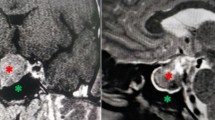Abstract
Cerebrospinal fluid (CSF) leak following initiation of Dopamine agonist therapy for macroprolactinomas, although uncommon, has been described previously in the literature. Traditional management includes primary repair of the defect using either fat or fascia lata in conjunction with lumbar drain insertion. In this case series we outline two cases of CSF leak secondary to invasive pituitary tumour that were repaired successfully using a nasoseptal flap. We believe that this form of repair is effective and associated with minimal morbidity.




Similar content being viewed by others
References
Tamasauskas A, Sinkūnas K, Draf W, Deltuva V, Matukevicius A, Rastenyte D, Vaitkus S (2008) Management of cerebrospinal fluid leak after surgical removal of pituitary adenomas. Medicina (Kaunas) 44(4):302–307
Abuabara A (2007) Cerebrospinal fluid rhinorrhoea: diagnosis, management. Med Oral Patol Oral Cir Bucal 12(5):E397–E400
Honegger JB, Psaras T, Petrick M, Beuschlein F, Reincke M (2006) Spontaneous cerebrospinal fluid rhinorrhea in untreated macroprolactinoma–an indication for primary surgical therapy. Zentralbl Neurochir 67(3):149–154
Jones NS, Becker DG (2001) Advances in the management of CSF leaks. BMJ 322:122–123
Baskin DS, Wilson CB (1982) CSF rhinorrhea after bromocriptine for prolactinoma. N Engl J Med 306(3):178
Cappabianca P, Lodrini S, Felisati G, Peca C, Cozzi R, Di SA et al (2001) Cabergoline-induced CSF rhinorrhea in patients with macroprolactinoma. Report of three cases. J Endocrinol Invest 24(3):183–187
Hadad G, Bassagasteguy L, Carrau RL, Mataza JC, Kassam A, Snyderman CH, Mintz A (2006) A novel reconstructive technique after endoscopic expanded endonasal approaches: vascular pedicle nasoseptal flap. Laryngoscope 116(10):1882–1886
Zweig JL, Carrau RL, Celin SE, Schaitkin BM, Pollice PA, Snyderman CH, Kassam A, Hegazy H (2000) Endoscopic repair of cerebrospinal fluid leaks to the sinonasal tract: predictors of success. Otolaryngol Head Neck Surg 123(3):195–201
Hegazy HM, Carrau RL, Snyderman CH, Kassam A, Zweig J (2000) Transnasal endoscopic repair of cerebrospinal fluid rhinorrhea: a meta-analysis. Laryngoscope 110(7):1166–1172
Cavallo LM, Messina A, Esposito F, de Divitiis O, Dal Fabbro M, de Divitiis E, Cappabianca P (2007) Skull base reconstruction in the extended endoscopic transsphenoidal approach for suprasellar lesions. Neurosurg 107(4):713–720
Hardy J (1971) Transsphenoidal hypophysectomy. J Neurosurg 34(4):582–594
Sherman JH, Pouratian N, Okonkwo DO, Jane JA Jr, Laws ER (2008) Reconstruction of the sellar dura in transsphenoidal surgery using an expanded polytetrafluoroethylene dural substitute. Surg Neurol 69(1):73–76, discussion 76
Cappabianca P, Cavallo LM, Esposito F, Valente V, De Divitiis E (2002) Sellar repair in endoscopic endonasal transsphenoidal surgery: results of 170 cases. Neurosurgery 51(6):1365–1371
Esposito F, Dusick JR, Fatemi N, Kelly DF (2007) Graded repair of cranial base defects and cerebrospinal fluid leaks in transsphenoidal surgery. Neurosurgery 60(4 Suppl 2):295–303; discussion 303–4
Kelly DF, Oskouian RJ, Fineman I (2001) Collagen sponge repair of small cerebrospinal fluid leaks obviates tissue grafts and cerebrospinal fluid diversion after pituitary surgery. Neurosurgery 49(4):885–889
Nishioka H, Haraoka J, Ikeda Y (2005) Risk factors of cerebrospinal fluid rhinorrhea following transsphenoidal surgery. Acta Neurochir (Wien) 147(11):1163–1166
Seiler RW, Mariani L (2000) Sellar reconstruction with resorbable vicryl patches, gelatin foam, and fibrin glue in transsphenoidal surgery: a 10-year experience with 376 patients. J Neurosurg 93(5):762–765
Nishioka H, Izawa H, Ikeda Y, Namatame H, Fukami S, Haraoka J (2009) Dural suturing for repair of cerebrospinal fluid leak in transnasal transsphenoidal surgery. Acta Neurochir (Wien) 151(11):1427–1430
Fortes FS, Carrau RL, Snyderman CH, Prevedello D, Vescan A, Mintz A, Gardner P, Kassam AB (2007) The posterior pedicle inferior turbinate flap: a new vascularized flap for skull base reconstruction. Laryngoscope 117(8):1329–1332
Author information
Authors and Affiliations
Corresponding author
Rights and permissions
About this article
Cite this article
Thakur, B., Jesurasa, A.R., Ross, R. et al. Transnasal trans-sphenoidal endoscopic repair of CSF leak secondary to invasive pituitary tumours using a nasoseptal flap. Pituitary 14, 163–167 (2011). https://doi.org/10.1007/s11102-010-0274-z
Published:
Issue Date:
DOI: https://doi.org/10.1007/s11102-010-0274-z




